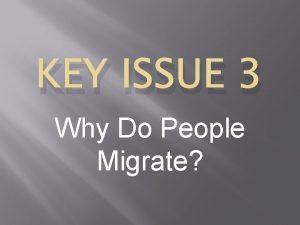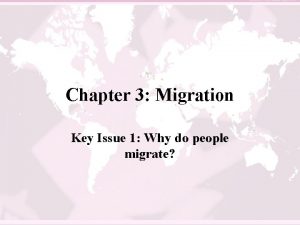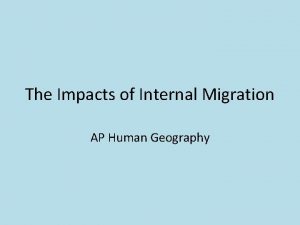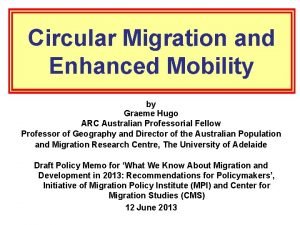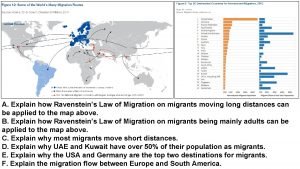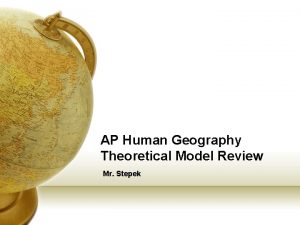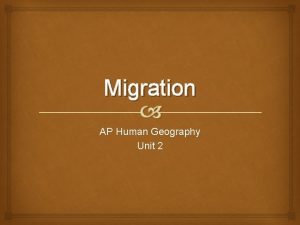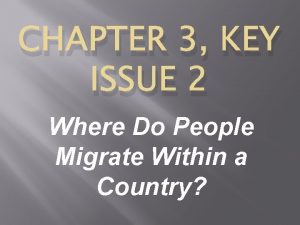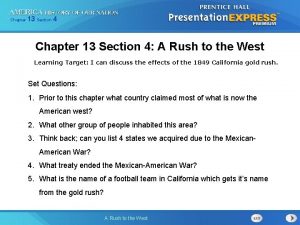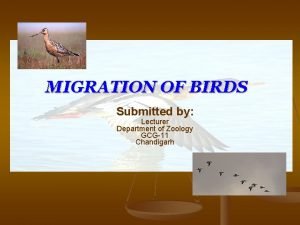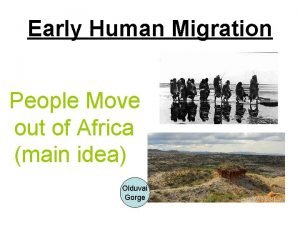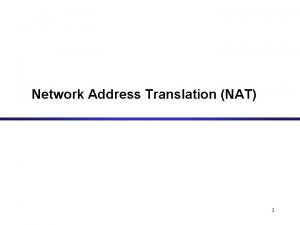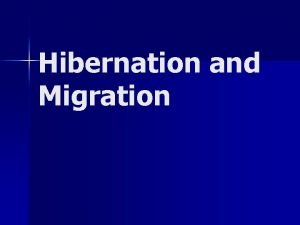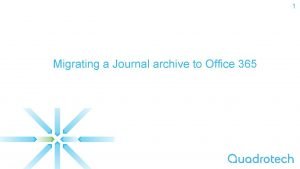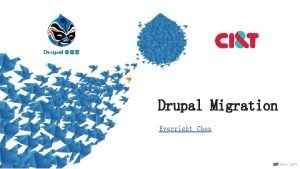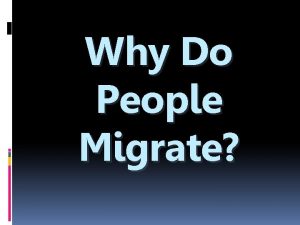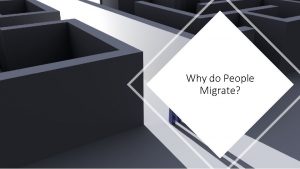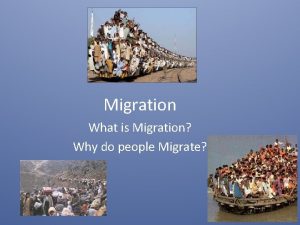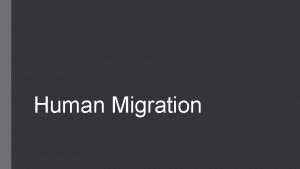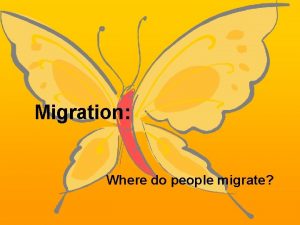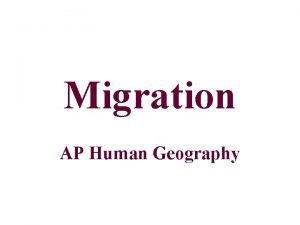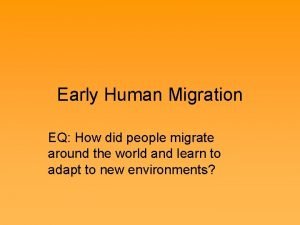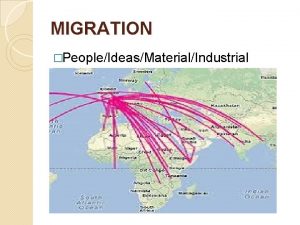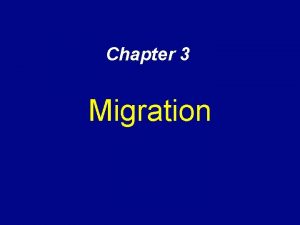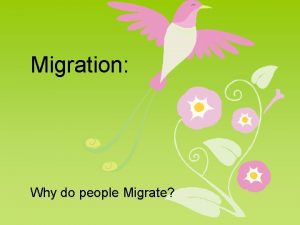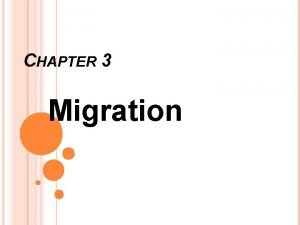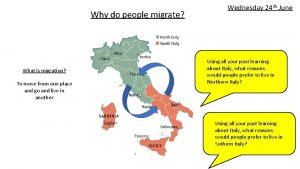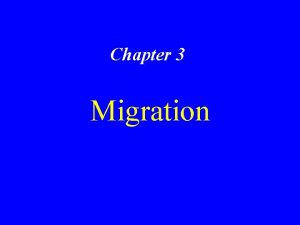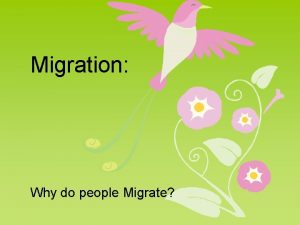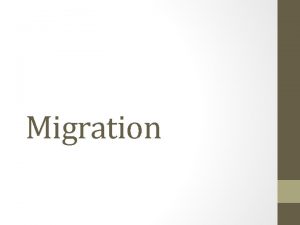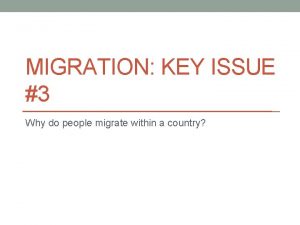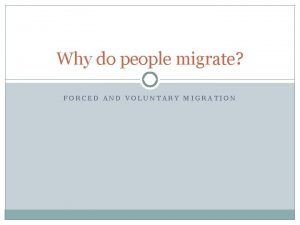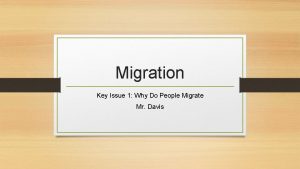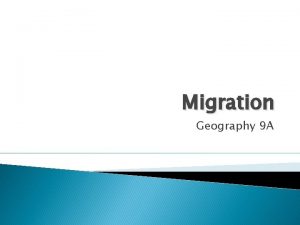Migration Why Do People Migrate AP Human Geography
























- Slides: 24

Migration Why Do People Migrate? AP Human Geography

Where and Why • Geographers want to understand two things: – Where people are moving FROM – Where people are moving TO – They also need to understand the circumstances of those places/situations to understand what motivates people to migrate

Migration • Is defined as: – A permanent move to a new location

In/Out Migration • Emigration- E is for exiting! Moving away from a place. – She emigrated from China. • Immigration- “im”=“IN” Moving to (into) a new place – She immigrated to the United States.

Emigration/Immigration Growth • Net- Migration is the total number of people moving into or out of a country. • Net Migration Formula: – Immigrants MINUS emigrants= Net Migration – If the formulated number is positive: • Net-In Migration. – If the formulated number is negative: • Net-out Migration.

Why do People Migrate? • Push Factors-induces people to move away from current location • Pull Factors-induces people to move into a new location • These usually oppose one another

Mobility • Different than migration • Mobility is about routine or general movement • Two types of mobility: – Circulation- daily, weekly routine – Seasonal- annually (Transhumance-movement of livestock to higher elevation during summer and lower elevations in winter)

Three categories of Migration • Economic Opportunity • Cultural/Political Freedom • Environmental Factors

Economic Factors • Most people migrate for economic reasons • Relocation for new employment opportunities – North Dakota-oil fields • Push factors- unemployment, factory closure

Cultural/Political Factors • Refugees- forced migration from their home to seek asylum in another country. **cannot return, must wait for another country to allow them in. – Lost Boys of Sudan – Syrians • Forced Migrants- literal force from home by political or environmental forces. Examples: – – Native American relocation to reservations. Jews to concentration camps Japanese internment camps Slavery

Environmental Factors • Typically voluntary • Choose to move to warmer climates • Southern regions of US has seen a large net-in migration pattern in the last 50 years. • This region is known as the Sun Belt. • Can include some forced migration such as natural disaster circumstances. – Hurricane Katrina – Dust Bowl

Additional Migration Draws • Environmental– Place Utility: additional factors that draw people/consumers/businesses to new locations.

Place Utility • With the invention of the air conditioner people could move to southern more desirable places (i. e places without winter) • This was a large market area so as the factory closures of the 1980’s-1990’s pushed people from the north (economical) and pulled people to the south (environmental) there was competition for these new residents

Place Utility Cont. • There needed to be some incentives for people to move into new states and neighborhoods. • Tax breaks, parks, sports arenas etc drew in new migrants. • http: //www. youtube. com/watch? v=SN 0 ch. NE B 2_U

Ravenstein’s Laws of Migration 1885* what is valid and what has changed? • Most migration is over a short distance • Migration occurs in a series of steps • Long distance migrants usually move to centers of economic opportunity (urban areas) • Each migration produces a movement in the opposite direction, counter stream. • People in rural areas migrate more than people in cities • Men migrate over longer distances than women • Most migrants are young adult males • Cities grow more by migration than by natural increase • Migration increases with economic development • Migration is mostly due to economic causes.

Migration Transition • Using the DTM to determine the type of migration that is typical for each stage of development • Stage 1: no country • Stage 2: International/Interregional migration • Stage 3: Internal/intraregional migration • Stage 4: Internal/intraregional migration

The Human Capital Model • Larry Sjaastad in 1962 • William A. V. Clark 1986 • Theory states that: – People seek to improve income over their lifespan so weigh the cost-benefits of migrating. – People migrate less as they age, because income is accumulated over time and potential decreases with age – That psychological and economic factors are both weighed prior to migration

Psychological Considerations • Migration is impacted by major turning points in a persons life. – College, employment, marriage, children and retirement – More flexibility when you are younger – As people age they are less* likely to migrate – People with children tend to migrate intraregional *snow birds/retirees

Distance Migration • Types of emigrational patterns: – Intercontinental/International- cross ocean or continent – Internal • Interregional • Intraregional

Inter-continental/national Migration • Two types of international migration – Requires a large sum of money and usually some form of sponsorship. – There is acculturation that occurs because of the distance decay that takes place within this form of migration. (loss of culture that typically takes place within three generations) – Chain migration also takes place within this form as people become established they send for their loved ones, causing a chain reaction.

Internal Migration • Two types of Internal Migration – Interregional- from one region to another – Intraregional- within one region

Interregional Migration • Movement between regions of the same country • Snowbirds-retirees

Sun Belt v. Rust Belt

Intraregional Migration • • Movement within the same region. Usually rural to urban Primarily economically motivated Within the last half century there has been a trend outward from urban to rural.
 What is immigration
What is immigration Key issue 3 why do people migrate
Key issue 3 why do people migrate Key issue 3: why do people migrate?
Key issue 3: why do people migrate? Internal migration definition ap human geography
Internal migration definition ap human geography Internally displaced persons ap human geography definition
Internally displaced persons ap human geography definition Circular migration definition ap human geography
Circular migration definition ap human geography Site:slidetodoc.com
Site:slidetodoc.com Stimulus diffusion
Stimulus diffusion Mobility ap human geography
Mobility ap human geography Key issue 2: where do people migrate within a country?
Key issue 2: where do people migrate within a country? Why did the mormons migrate to utah
Why did the mormons migrate to utah Cedar waxwing bird
Cedar waxwing bird Why why why why
Why why why why Frq format ap human geography
Frq format ap human geography 5 themes of geography ap human geography
5 themes of geography ap human geography Stateless nation
Stateless nation Human development index definition ap human geography
Human development index definition ap human geography Human migration map
Human migration map Migrate network address translation
Migrate network address translation Do hedgehogs hibernate or migrate
Do hedgehogs hibernate or migrate Azure migrate demo
Azure migrate demo Migrate journal mailbox to office 365
Migrate journal mailbox to office 365 Drupal migrate d2d
Drupal migrate d2d Migrate siebel to salesforce
Migrate siebel to salesforce What is the current intraregional migration trend in the us
What is the current intraregional migration trend in the us

